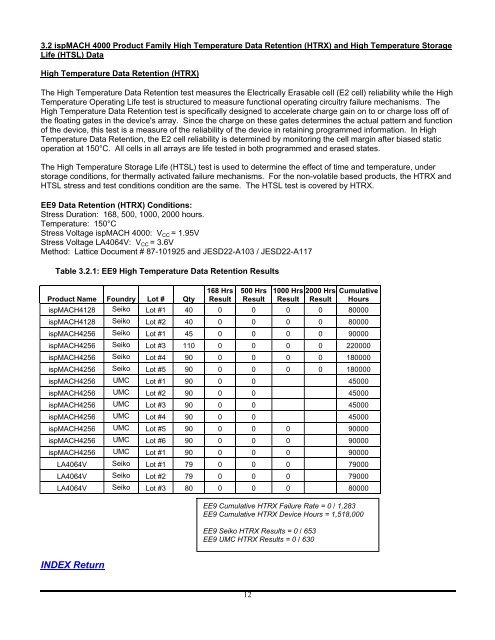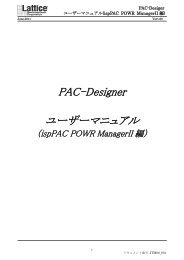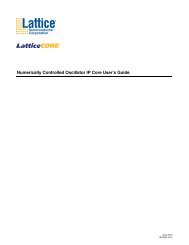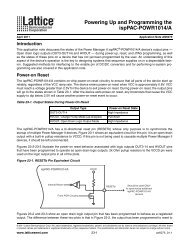Lattice ispMACH 4000 ZC/ZE Product Family Qualification Summary
Lattice ispMACH 4000 ZC/ZE Product Family Qualification Summary
Lattice ispMACH 4000 ZC/ZE Product Family Qualification Summary
You also want an ePaper? Increase the reach of your titles
YUMPU automatically turns print PDFs into web optimized ePapers that Google loves.
3.2 <strong>ispMACH</strong> <strong>4000</strong> <strong>Product</strong> <strong>Family</strong> High Temperature Data Retention (HTRX) and High Temperature Storage<br />
Life (HTSL) Data<br />
High Temperature Data Retention (HTRX)<br />
The High Temperature Data Retention test measures the Electrically Erasable cell (E2 cell) reliability while the High<br />
Temperature Operating Life test is structured to measure functional operating circuitry failure mechanisms. The<br />
High Temperature Data Retention test is specifically designed to accelerate charge gain on to or charge loss off of<br />
the floating gates in the device's array. Since the charge on these gates determines the actual pattern and function<br />
of the device, this test is a measure of the reliability of the device in retaining programmed information. In High<br />
Temperature Data Retention, the E2 cell reliability is determined by monitoring the cell margin after biased static<br />
operation at 150°C. All cells in all arrays are life tested in both programmed and erased states.<br />
The High Temperature Storage Life (HTSL) test is used to determine the effect of time and temperature, under<br />
storage conditions, for thermally activated failure mechanisms. For the non-volatile based products, the HTRX and<br />
HTSL stress and test conditions condition are the same. The HTSL test is covered by HTRX.<br />
EE9 Data Retention (HTRX) Conditions:<br />
Stress Duration: 168, 500, 1000, 2000 hours.<br />
Temperature: 150°C<br />
Stress Voltage <strong>ispMACH</strong> <strong>4000</strong>: VCC = 1.95V<br />
Stress Voltage LA4064V: VCC = 3.6V<br />
Method: <strong>Lattice</strong> Document # 87-101925 and JESD22-A103 / JESD22-A117<br />
Table 3.2.1: EE9 High Temperature Data Retention Results<br />
168 Hrs 500 Hrs 1000 Hrs 2000 Hrs Cumulative<br />
<strong>Product</strong> Name Foundry Lot # Qty Result Result Result Result Hours<br />
<strong>ispMACH</strong>4128 Seiko Lot #1 40 0 0 0 0 80000<br />
<strong>ispMACH</strong>4128 Seiko Lot #2 40 0 0 0 0 80000<br />
<strong>ispMACH</strong>4256 Seiko Lot #1 45 0 0 0 0 90000<br />
<strong>ispMACH</strong>4256 Seiko Lot #3 110 0 0 0 0 220000<br />
<strong>ispMACH</strong>4256 Seiko Lot #4 90 0 0 0 0 180000<br />
<strong>ispMACH</strong>4256 Seiko Lot #5 90 0 0 0 0 180000<br />
<strong>ispMACH</strong>4256 UMC Lot #1 90 0 0 45000<br />
<strong>ispMACH</strong>4256 UMC Lot #2 90 0 0 45000<br />
<strong>ispMACH</strong>4256 UMC Lot #3 90 0 0 45000<br />
<strong>ispMACH</strong>4256 UMC Lot #4 90 0 0 45000<br />
<strong>ispMACH</strong>4256 UMC Lot #5 90 0 0 0 90000<br />
<strong>ispMACH</strong>4256 UMC Lot #6 90 0 0 0 90000<br />
<strong>ispMACH</strong>4256 UMC Lot #1 90 0 0 0 90000<br />
LA4064V Seiko Lot #1 79 0 0 0 79000<br />
LA4064V Seiko Lot #2 79 0 0 0 79000<br />
LA4064V Seiko Lot #3 80 0 0 0 80000<br />
INDEX Return<br />
EE9 Cumulative HTRX Failure Rate = 0 / 1,283<br />
EE9 Cumulative HTRX Device Hours = 1,518,000<br />
EE9 Seiko HTRX Results = 0 / 653<br />
EE9 UMC HTRX Results = 0 / 630<br />
12










